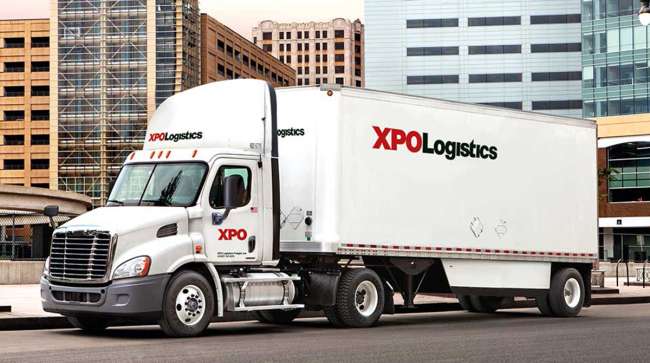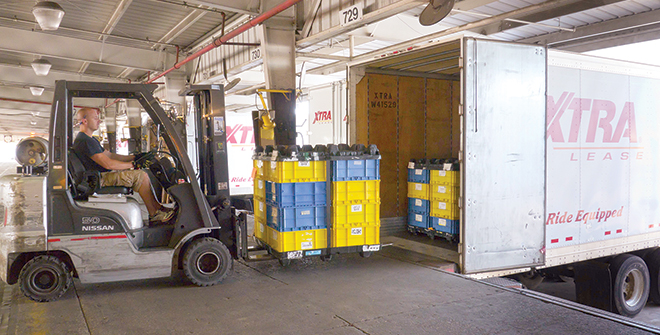Tonnage Rise Pushes Spot Rates Higher

Truck tonnage rose 8.8% in January on a year-over-year basis, according to American Trucking Associations’ monthly for-hire truck tonnage index.
The news also was good on a sequential basis as tonnage increased 2% from December to January. The seasonally adjusted index was 111.6 last month, up from 109.4 in December.

Costello
“Last month’s gain in tonnage fit with the anecdotal reports we have been hearing from fleets — that freight was solid in what is typically a softer month,” ATA Chief Economist Bob Costello said. “With the economy strong, the drivers of truck freight solid and the inventory cycle in favor of motor carriers, I expect freight tonnage to remain robust in the months ahead.”
For all of 2017, the index increased 3.8% over 2016.
ATA recently revised the seasonally adjusted index back five years as part of its annual revision. Also, ATA reindexed the seasonally adjusted and not-seasonally adjusted tonnage indexes to 2015 = 100 back to 1973.
The not-seasonally adjusted index, which represents the change in tonnage actually hauled by the fleets before any seasonal adjustment, equaled 106.9 in January, which was 0.4% above the previous month.
In other industry measures, the For-Hire Trucking Index from ACT Research rose in January to an all-time high for its 10-year history.

Denoyer
“Clearly, the pendulum of pricing power rests with truckers as 2018 contract negotiations with shippers are getting underway,” ACT Research Vice President Tim Denoyer said. “The data provide further support for 2018 contract rate increases, which are pressing up towards double digits, especially with the ongoing difficulties [carriers] are having with capacity/drivers.”
Columbus, Ind.-based ACT Research publishes data and analysis on the North American commercial vehicle market.
DAT Solutions reported that capacity remained tight in January due to shipper demand and fallout from the Dec. 18 enactment of the Federal Motor Carrier Safety Administration’s electronic logging device mandate, which requires most truck drivers to electronically track hours of service.
The mandate led to records for spot truckload rates for dry van, refrigerated and flatbed freight dating to 2010, when DAT began tracking spot market freight rates.
“We saw an immediate 10% decline in truck posts on our boards” after the mandate, and truck capacity fell 6.9%, said Mark Montague, senior pricing analyst with DAT.
The national average spot van rate set a record at $2.26 per mile in January, up 15 cents compared with December and 59 cents higher than January 2017. The spot reefer rate, at $2.66 per mile, was 71 cents higher compared with January 2017. And the national average flatbed spot rate was $2.39 per mile, 47 cents higher year over year.
As of mid-February, Montague said demand in the usually slow month was pacing ahead of January.
“The energy sector is still hot, with very robust movement out of the Gulf Coast,” he said.

Xtra Lease Inc.
The Cass Truckload Linehaul Index grew in January 6.5% year-over-year to 133.5. The index has been in positive territory for 10 straight months. The index measures market fluctuations in per-mile truckload linehaul rates, independent of additional costs such as fuel and accessories.
“In the last seven months, our pricing forecast has increased from -1% to 2% to 6% to 8%, and now is giving us reason to believe the risk to our estimate continues to be on the upside,” Cass analyst Donald Broughton said. “The current strength being reported in the spot rates tells us contracting rates should keep rates in positive territory well into 2018.”
The Cass Intermodal Price Index rose 5% year-over-year to an all-time high of 141.4 in January. Pricing momentum remains strong with higher diesel prices creating demand, Broughton noted. The intermodal index is a measure of market fluctuations in U.S. domestic intermodal costs.
“Longer term, we continue to foresee oil trading in the $45-to-$65 range and diesel in the $2.50-to-$3.25 range throughout 2018,” he said.
Cass manages $25 billion annually in freight spend and uses the data to create indicators of transportation industry trends.
The Chainalytics-Cowen freight indices in December rose to levels not seen since 2014, indicating spot rates were rising faster than contract rates. The indices lag the market by a month. Cowen reports the increase is a good sign for carriers as spot rates for both dry van and reefers rose 7% above contract rates. Indicators for the broader U.S. economy appeared mixed in January.
The Institute for Supply Management manufacturing index came in at 59.1% in January, a decrease of 0.2 percentage point from the seasonally adjusted December reading of 59.3%. Of the 18 manufacturing industries, 14 reported growth in January.
The Federal Reserve’s gauge of industrial production fell 0.1% in January to 107.2, though that is an increase of 3.75% from January 2017.
In housing, there were 1.326 million January starts on an annualized basis, a rise of 9.7% from a revised December number and 7.3% above the January 2017 figure, according to the Census Bureau.
Retail consumer sales dropped 0.3% from December 2017 to $492 billion in January, the Census Bureau reported. However, that was up 3.6% from January 2017. The inventory-to-sales ratio, which lags the market by a month, fell to 1.22 in December from 1.46 in November. In general, a lower number is good for the trucking industry because it indicates products are moving through the supply chain and not sitting in warehouses.

